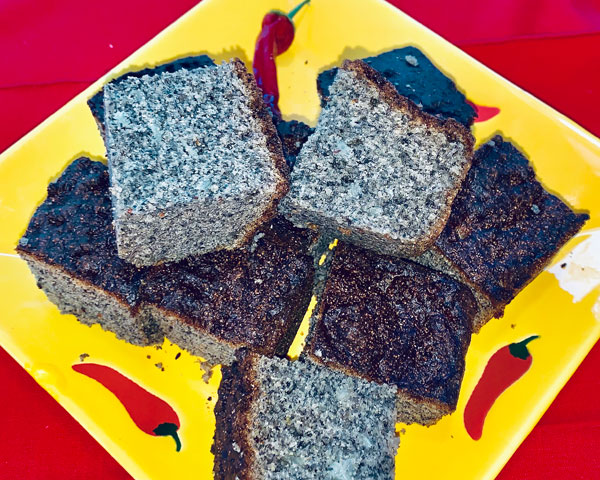
Today I am thrilled to be sharing a Zia Blue Cornbread recipe from Bill Robinson, manager of The Crazy Chile Farm in east Maricopa County, Arizona. The Crazy Chile farm is a small farm located between the rugged Superstition Mountains and the Saguaro-covered Usery Mountains. The farm grows “rare landrace chiles and a number of other traditional, desert-adapted Native American crops“. It is a community farm with most of the people that work the farm living in the area. The “profits” and produce are used to keep the farm going, as well as to assist those in need that live in the surrounding areas. To learn more about this farm, click on the above link.
Bill has spent years learning about the ingredients and cuisine of the southwestern Native Americans, and how their recipes has been fused with other cuisines. In addition to his research, he also enjoys making the traditional recipes and their modern versions. Bill has been very generous in supplying me with the following post which includes a recipe for Zia Blue Cornbread, a traditional Feast Day bread of the Zia Pueblo, New Mexico. The Zia Pueblo is “situated in the steep mountains slopes and canyons of the Sierra Nacimiento Mountains. The gently sloping flood plain of the Jemez River, and the large Pajarito and Jemez Plateaus establish the setting for the Zia Indian Reservation” (zia.com). Thanks Bill!
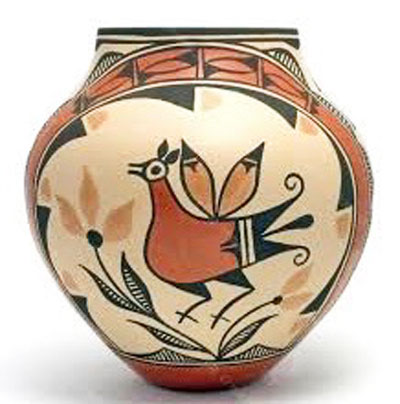
Zia Blue Cornbread
by Bill Robinson
Cornbread is a fine example of the combination of New and Old-World ingredients. It came into existence after the voyages of Christopher Columbus, when Western Hemisphere maize (corn) was mixed with the European/Arabian complement of wheat, eggs, milk, sugar, oils, and leavening. It was then cooked in an horno (a domed, “beehive,” adobe oven) still popular in the Rio Grande Valley of New Mexico and West Texas. These ovens originated in Egypt in the Valley of another famous river, the Nile. Along with a host of agricultural techniques, the horno was introduced to the Iberian Peninsula in the late 700s, when the Islamic Moors began their lengthy occupation. Hornos began to be used in the Western Hemisphere not long after the Spanish invasion of Teotihuacan in 1519.
If you would like to experience the cornbread served in many contemporary Native American homes, the easiest way would be to add these few ingredients to a standard cornbread recipe: 2 tablespoons powdered red or green chile, a quarter-cup each of grated cheese, canned corn, chopped onions, and chopped green chiles. Start with 2 teaspoons of chile powder and vary that amount (up or down) on successive batches until the heat is where you like it.
If you would like to try a more traditional recipe, here’s one from the Medina family at Zia Pueblo, New Mexico. Once a year, on their annual Feast Day of August 15th, the people of Zia perform a corn dance. Many people come to Zia to see the dances and share in the festivities. This is the cornbread the Medinas serve to their neighbors and guests.
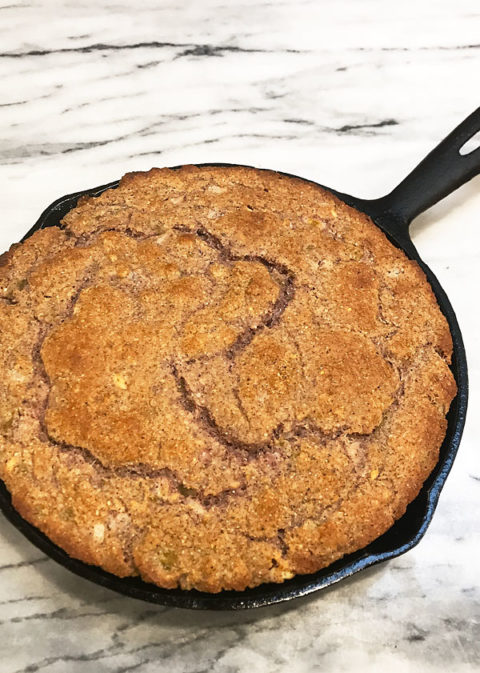
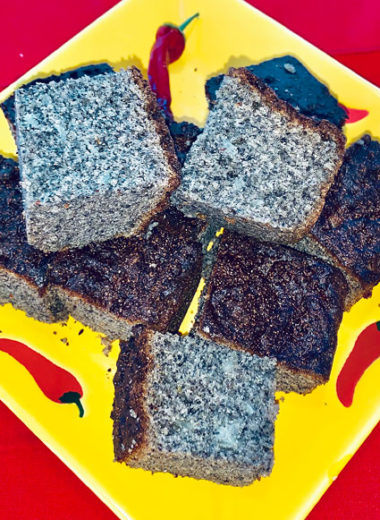
A mildly sweet and spicy green chile cornbread made with blue cornmeal. The Medina Family of the Zia Pueblo, New Mexico (NM), makes this traditional cornbread for neighbors and guests of the pueblo's annual Feast Day in August. They double the recipe for Feast Day! It's easy to half or double this recipe.
*See Kitchen Notes for more information, substitutions and related links. Also, MJ provides her recipe adjustments for cutting the recipe in half.
- 2 cups blue cornmeal* (or yellow cornmeal)
- 2 Tbsp wood ash* (optional), preferably made from Juniper or a related species.
- 1 cup flour (substitute a gluten free flour* if you require it)
- 2 tsp baking powder (1 tsp. if using a leavened flour mix)
- 1 – 4 tsp red or green chile powder, to taste
- 2 tsp garlic powder or 2 cloves of pressed garlic
- 1 ½ cup milk or buttermilk
- 1/3 cup Agave syrup or 1/4 C sugar (brown or turbinado)
- 2 eggs, gently whisked
- 4 Tbsp grated/crumbled cheese* (Romano or Cotija)
- 1 small can mild or medium chopped green chile OR 1/4 cup roasted fresh green chile, peeled and chopped
- 1/2 cup finely chopped onions
- 2 Tbsp cooking oil* (to grease pan/skillet)
Preheat oven to 375°F.
In a mixing bowl, thoroughly mix the cornmeal and the wood ash.
Add the rest of the dry ingredients.
Mix the wet ingredients together and add to the dry ingredients. Combine well to incorporate wet and dry ingredients. Don't over stir, but do make sure that all of the flour and cornmeal is incorporated.
At the Zia Pueblo cornbread is usually cooked in a cast iron skillet. If this is what you use, grease the iron skillet with the oil. You could also use any oven-safe skillet or baking dish.
Pour the cornbread mix into the skillet and bake in pre-heated oven for 35 minutes.
If you prefer to use an Air Fryer, use an aluminum pan, Pyrex® baking dish, or silicone container and cook at 365°F for 20 min.
Blue cornmeal – If you can’t find blue cornmeal, substitute with a fine ground yellow corn meal. Bill uses a Ute Mountain Ute Bow and Arrow blue cornmeal. The Ute Mountain Ute Indian Reservation is located in southwestern Colorado, northwestern New Mexico and small sections of Utah. MJ used a Tamaya Blue from the Santa Ana Pueblo, New Mexico. Bill’s cornbread is the beautiful blue cornbread in the top picture. MJ’s (made with a different blue cornmeal and no wood ash), is the cornbread in the third photo which isn’t near as blue as Bill’s.
Wood ash – The wood ash is optional. It’s purpose is to create a deep blue color and enhance the flavor of the cornmeal. Be sure that the wood ash you use is from untreated wood, possibly organic. There are a few sources of wood ash online.
Gluten-free Flour – If using a gluten free baking mix (which is pre-leavened), reduce baking powder to 1 teaspoon.
Cheese – A strong, salty cheese (cotija, Romano, Feta) is best, but you could also use a sharp cheddar.
Cooking Oil – Use oil if you are vegetarian, vegan, or just want to keep it healthy. MJ loves using bacon dripping for cornbread and baking the cornbread in a cast iron skillet. She melts the drippings in the cast iron while preheating the oven. Just make sure to remove the skillet once the drippings have melted so they won’t burn.
Cutting the recipe in half (4 servings) – All in all it’s pretty straight forward because most ingredients can be just cut in half. Here are the adjustments I (MJ) did NOT cut in half. For the dry ingredients I used 1.5 teaspoon baking powder, 1 large garlic clove (smashed/minced), and omitted the chile powder. For the wet ingredients, I used 3/4 cup buttermilk (not milk), 2 Tbsp. agave syrup, 2 heaping Tbsp. crumbled feta cheese, and 1/4 cup minced, roasted green chile. Baking time: Since it was a smaller batch, I only baked it for 25 minutes. As you can see, I did eliminate the chile powder because I added 1/4 cup roasted chile used in a whole batch. I also eliminated the wood ash because I didn’t have any. Because of that, my cornbread did have a duller blue color than Bill’s.
Thank you Bill for such an informative post and delicious recipe. I did make this cornbread; therefore, I can honesty say that it is delicious. The small amount of agave used in the recipe provides a little bit of sweetness but nothing compared to the sweet cornbread found in the southern United States. Then of course, the roasted chile gives it that delightful green chile flavor without making the bread too spicy. I found it to be perfectly sweet and spicy.
Below are more cornbread recipes you will enjoy.

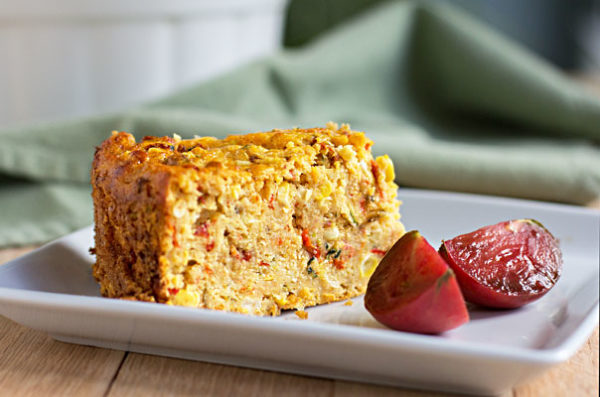
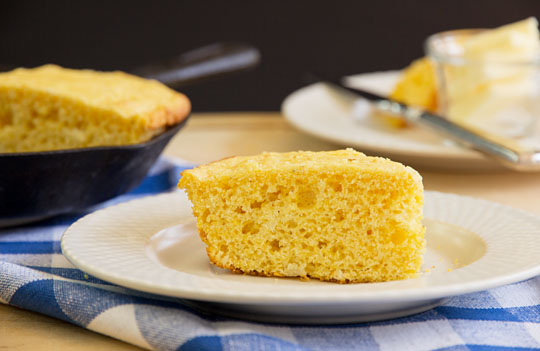
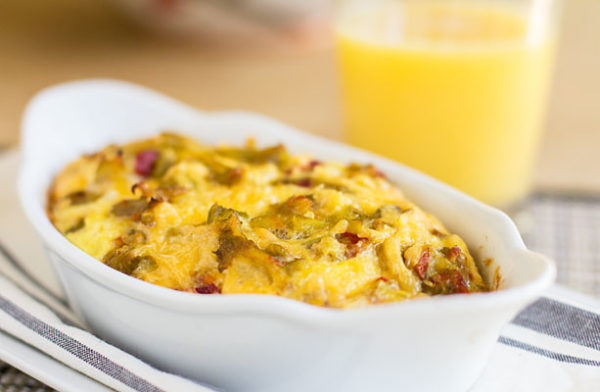
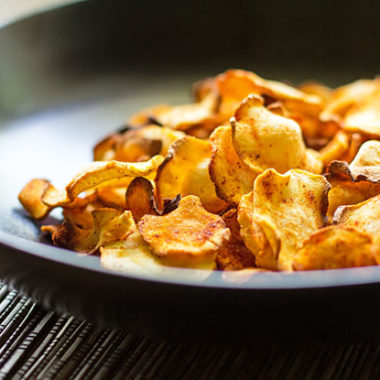


I suspect great things from this:). I’m making it for Thanksgiving, woot! I’ll have to use a Peruvian Blue Cornmeal – any thoughts?
I made the recipe as described in a skillet and it is beautiful. It tastes good but the garlic is too strong. I think 2 cloves pressed would be perfect or 2 tsp minced but 2 teaspoons of powder is equivalent to 16 cloves of garlic per the conversion I looked up. I’ll try the 2 cloves pressed next time or 1/4-1/2 teaspoon of the powder. I think the ash really adds to the finished product.
David, Thanks for your comment! Thrilled that you were pleased with the outcome except for the garlic. I usually find recipes don’t have enough garlic. 🙂 The pressed cloves sounds like a great solution. Cheers, MJ
This looks wonderful! I bought some of the Ute Mountain blue cornmeal this summer when we were Cortez Colorado. I just ordered some juniper ash as well to make it authentic. Thank you for the recipe!
Excellent! I hope you enjoy it. The ash will definitely help to maintain the beautiful color of the cornmeal as well as enhance the flavor. Hope you like it. Please let me know and I’ll share your feedback with the recipe developer. Cheers, MJ
This is a great-looking bread. I’ve never seen blue corn, I didn’t even know it existed. I would love to have some.
how interesting. i’m not sure if we have blue cornmeal here – possibly in specialty delis… and the idea of adding wood ash is new to me. does it add flavour too?
MJ, what a treat. Thank you so much for sharing this recipe. Aside from the wood ash, I will be able to prepare this at home and look forward to making the recipe.
MJ, five stars and more. Loved reading every word of your post. You both express so effortlessly the kitchen happenings. I’m amazed.
Blue cornmeal is new to me as well. I have yellow cornmeal in my pantry that my better half bought assuming it to be coarse semolina. Your recipe sounds a treat and I might just as well give a try. Thank you for the kitchen notes especially, very helpful.
Thank you so much Hasin. I hope you do give this recipe a try. Yellow cornmeal will work just fine. Enjoy! Cheers, MJ
What an interesting story as well as recipe, thank you both for sharing.
Thanks Karen. Bill’s an interesting guy!
Looks so flavorful and delicious😋😋 it’s been a while I last commented on your blog Happy to get connected again . Glad you stopped by at my space .. Take care and have a great day.
Thanks Gloria. Love seeing you again! I’ll be back to your site as well. Take care.
well how cool is this? I’ve never come across blue cornbread before, what a revelation. I’ll keep my eyes open for it – pretty sure I can find it (be great in pancakes/waffles too I bet). Also admiring the pottery – i’ve never seen a roadrunner in person (so to speak ;0) — do you come across them often MJ? love it.
Thanks Kelly. If you find some blue cornmeal, check out my blue cornmeal pancakes. They are our favorites along with your raspberry oatmeal. I think you’ll like them. That’s funny that you say you’ve never seen a roadrunner before. I’m on my front porch at the moment and a mother roadrunner and one of her youngins, just came up on the porch to say hello. 🙂 They live in my neighbor’s yard so we see them all of the time. They are wonderful to watch and keep my front yard free of snails.
Thank you MJ and Bill for a fun read and very interesting article. You know what, we have never had blue corn bread before but reading your ingredients list , this has to absolutely delicious. Need to get this on the menu plan soon.
Thanks Bobbi. Bill’s an interesting guy and has done some amazing research on southwest cuisine. I was thrilled when he sent me this article and recipe. Hope you can find some blue cornmeal. I love the flavor.
A great read, MJ! And a fascinating recipe. Does the wood ash add a smoky flavor?
Thanks Kelly. To be honest, I haven’t tried this with the wood ash, but I’ll ask Bill and get back with you. Sorry.
Great one ! I got lucky to find blue cornmeal in my neighbourhood when you published Blueberry Blue Corn Pancakes but must look for another delivery ! Thank you so much !
Thanks Davorka. I’m surprised you can get blue corn where you are. It’s hard to find in parts of the US. So glad you can get it and hope you did enjoy the pancakes. I make them whenever we get blueberries. Just too good to resist. 🙂
What a great read! Blue cornbread is really tasty and how special it is that you could share the Zia Blue Cornbread recipe! I have a bag of blue cornmeal on hand and would love to try this recipe with green chile. Coincidentally we made a day trip to Jemez over the weekend and saw the signs for the Zia Pueblo.
Thanks Jan. Next time you are in the Jemez, if the Pueblo has reopened, you should visit the museum. It’s very interesting.
I love the wood ash! So interesting. In a Mark Miller cookbook, Red Sage, he writes at great length about the Indians and their influence on food in the Great West and Southwest. So fascinating. Stephan Pyles turned me on to blue corn in the 80’s with his first cookbook. If you’re not familiar with him, he modernized and southersternized his beloved Texas cuisine in his first cookbook. I made a whole Thanksgiving one year with his recipes – blue corn and chorizo stuffing, sweet potato enchiladas with tomatillo sauce…. ETC. Anyway, sorry, got carried away with memories. Thanks for this recipe, although I wonder if Amazon sells wood ash?!
Thank Mimi. Yes, I am very familiar with Mark Miller. I have his Coyote Cafe cookbook. He is one of the best published chefs of New Mexico cuisine – IMO. There are others, but I really like his recipes. Glad to have brought back some memories 🙂 I did see wood ash at Amazon. Not much, but a few options.
Love the color, MJ!! I haven’t made cornbread in a LONG time and now you’ve given me a huge craving. YUM!
Thanks Liz. It’s amazing how much the wood ash enhances the blue of the cornmeal.
This looks delicious! I’ve been hoping to find a cornbread with little to no sugar, so I can’t wait to try this. Thank you MJ and Bill.
Thanks Susan. You’re right, a lot cornbread recipes have sugar and a traditional southern cornbread has A LOT of sugar. We don’t like it either, but in this blue cornbread, it’s just perfect because it is so well balanced with the spiciness of the green chile.
I have never seen, let alone, had some blue corn in my life. This cornbread looks and sounds terrific, MJ. I love the flavour and the dramatic colour. Beautiful!
Thanks Angie. It’s not common outside the southwest US I don’t believe. I use it in cornbread, for my atole and in pancakes. It’s yummy.
This looks wonderful! I’ve never had blue cornmeal, but now that I’ve seen this, I won’t rest until I get some. 🙂 Really neat — thanks.
Thanks John. You’re going to be surprised with the difference in flavor. I hope you enjoy.